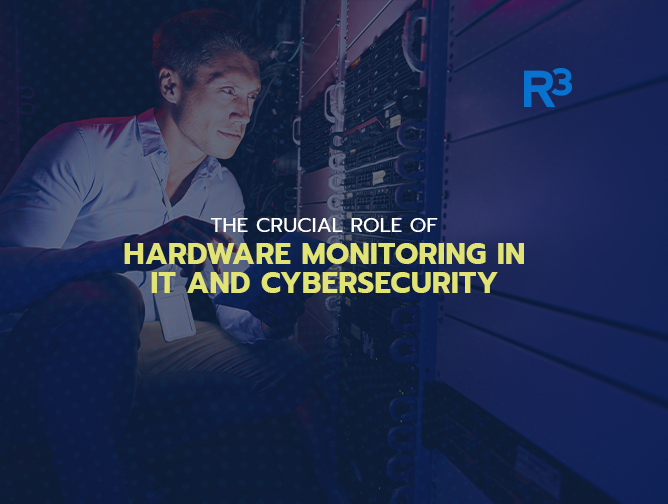In the fast-paced world of IT, hardware monitoring stands as a silent sentry, safeguarding the integrity and performance of an organization’s technology infrastructure. This blog post delves into the realm of hardware monitoring—a critical yet often underappreciated aspect of IT and cybersecurity—and how it benefits businesses, especially in a B2B context.
Why Hardware Monitoring Is Essential
For IT leaders at B2B organizations, hardware monitoring is not just a checkbox in a long list of maintenance tasks; it is the lifeblood that ensures operational continuity and security. As R3, Chief Technology Office, Kyle McNaney, aptly puts it:
“Hardware monitoring can enhance business operations by providing real-time insights into the health and performance of critical infrastructure components. By identifying potential hardware failures or bottlenecks early, businesses can proactively address issues, minimize downtime, and maintain productivity. Furthermore, leveraging hardware monitoring data enables informed decision-making regarding upgrades, resource allocation, and infrastructure optimization, ultimately fostering efficiency and cost-effectiveness.“
But what exactly is hardware monitoring? At its core, it is the continuous oversight of the physical components of a computer network, such as servers, routers, switches, and storage devices, to ensure they are operating within desired parameters.

Download 6 Common Cyber Attacks & How to Prevent Them
Check out our free eBook on 6 Common Cyber Attacks and How to Prevent them.
Case Studies and Impact Stories
One notable example of the impact of robust hardware monitoring systems is a large financial institution that managed to hone its security and operational efficiency. Through meticulous monitoring of their equipment, they were able to preemptively identify potential points of failure, optimizing uptime and customer trust.
Furthermore, consider the instance where effective hardware monitoring actually preempted a catastrophic cybersecurity breach. Immediate alerts to unusual hardware activity enabled IT personnel to lock down systems in the nick of time, showcasing just how critical real-time vigilance can be. Real-time visibility into the status of your hardware is essential in today’s threat landscape. It’s an ever present gatekeeper to your digital assets.
Key Benefits of Hardware Monitoring
- Early Detection of Hardware Failures: By foreseeing problems, businesses avert systemic downtime and ensure smoother operations.
- Enhanced Cybersecurity Posture: Monitoring creates a shield against intrusion by promptly detecting aberrant behavior that could signal a security breach.
- Proactive Performance Management: Maintaining optimal system performance is easier when you’re aware of the health of your hardware.
- Cost Savings: Anticipating breakdowns and reallocating resources efficiently can result in significant financial benefits.
- Support for Remote Work: Timely response to any hardware disruptions is ensured, which is particularly significant for remote teams reliant on cloud and VPN services.
14 Methods of Hardware Monitoring
A comprehensive hardware monitoring strategy involves various methods:
- SNMP Monitoring: Simple Network Management Protocol gathers data from various network devices to check for abnormal conditions.
- Temperature Monitoring: Specialized sensors detect overheating issues in servers and data centers.
- Performance Counters: Software that checks for memory usage, CPU load, network bandwidth utilization, and disk activity.
- Log Analysis: Examining logs generated by hardware to spot anomalies or signs of malfunctioning.
- RAID Monitoring: Overseeing Redundant Array of Independent Disks for faults.
- Remote Management Tools: Software like IPMI or HP’s iLO allow for out-of-band management of systems.
- Battery Monitoring: In UPS systems to ensure there’s no power interruption.
- Network Packet Analysis: Reviewing packets transferred over the network for signs of malicious activity.
- Physical Inspection: Regularly examining hardware for wear and tear or other physical damage.
- Firmware Version Tracking: Ensuring that the latest security patches are applied.
- Performing Regular Maintenance: Scheduled maintenance activities such as updating software, checking system configurations, and replacing outdated components to avoid hardware malfunctions.
- Implementing Redundant Systems: Establishing backup systems that take over operations in case primary systems fail, ensuring no single point of failure can disrupt the business workflow.
- Hardware Replacement Plan: Creating a structured approach to replace aging or failing hardware proactively, typically through a lifecycle management strategy to maintain updated and efficient systems.
- Regular Hardware Component Checks: Consistently inspecting individual hardware components for signs of wear or failure, allowing for timely repairs or upgrades to keep the infrastructure in top condition.
Essential Hardware Monitoring Tools
For IT and cybersecurity professionals, choosing the right hardware monitoring tools is akin to selecting the best guardians for their digital fortress. Below, we highlight four cutting-edge tools, each with its unique capabilities and applications:
- LogicMonitor
- PRTG
- Auvik
- Domotz
Each of these tools brings to the table a unique combination of features that can be tailored to fit the specific needs of an organization’s IT infrastructure. Whether it’s for a large-scale distributed network or a more contained setup, the right hardware monitoring solution enhances any cybersecurity strategy.
Closing Notes
Whether it’s for managing server farms or protecting against the latest cyber threats, hardware monitoring should be front and center in any IT leader’s strategy. The benefits, as outlined above, are profound and far-reaching—serving not just to prevent disaster but to promote excellence in daily operations.
Remember, when it comes to IT infrastructure, being proactive isn’t just wise—it’s imperative. Hardware monitoring is one of the many services we provide to our clients. To learn more view our managed services page and reach out to our team.
—
For more insights on IT strategies and best practices, follow our blog and join the conversation with other industry leaders.


